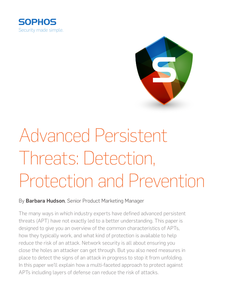Many papers on the topic of advanced persistent threats (APTs) begin with ominous references to the changing threat landscape and stories of how highly sophisticated cyber attacks are becoming more prevalent. That can be misleading. The majority of attacks today still use many techniques that have been around for years—social engineering, phishing emails, backdoor exploits and drive-by downloads, to name the biggest ones. Such attacks are neither advanced nor particularly sophisticated when broken down into their individual components and often rely on the weakest link in any organization—the user. However, the way in which hackers use combinations of techniques and the persistent behavior of the attackers is something that does set APTs apart from other attempts to compromise security.
This paper is designed to give you an overview of the common characteristics of APTs, how they typically work, and what kind of protection is available to help reduce the risk of an attack.

